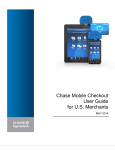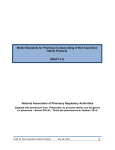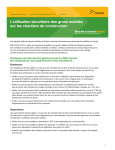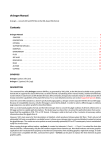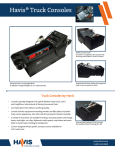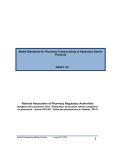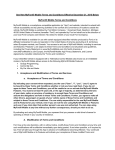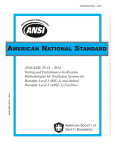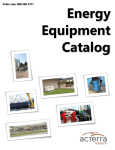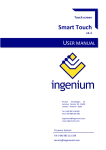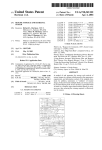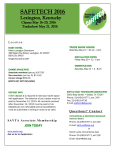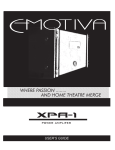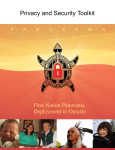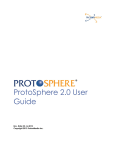Download 01 - Bay Area Environmental Safety Group
Transcript
Safety Insider Meeting Time and Location January 2013 Wednesday, March 21, 2012 Membership Renewal 12:00 – 1:00 PM Don’t let your BAESG memberships expire. Membership renewals are Registration starts at 11:30 AM $50, and are due by March 1st. Renew by mail by completing the enclosed membership application on page 5 or bring it to the next Hilton Santa Clara monthly meeting. Membership benefits include: 4949 Great America Parkway Discount on Monthly Meetings: Network, stay informed, and eat well Santa Clara, CA Membership Directory: Keep in touch with colleagues and friends (408) 330 – 0001 Meeting Time Newsletter: Stay up to date with all the goings-on and Location Job Announcements: Know what is out there For directions go to Subsidized Holiday Party: Start off the season with a great getwww.baesg.org Wednesday, January 16, 2013 together 12:00 – 1:00 PM RSVP at Upcoming Meetings Registration starts at 11:30 AM [email protected] Discussion Topic Date Scheduled Speaker Hilton Santa Clara 4949 Great America Parkway California Environmental January 16 Michael Balliet, Santa Clara, CA Regulatory Structure and Local Santa Clara County Agency Implementation (408) 330 – 0001 Topic to be determined February Tony Gilmore, For directions go to 20 SVBX Construction Safety and Security www.baesg.org Manager RSVP at Global Harmonized System March 20 Speaker to be [email protected] determined Aging and changing workforce. April 17 Jerry Bach, VP, Workplace Safety & Health Service for Safety Center Bay Area Environmental Safety Group President’s Corner Meeting Location Advertisements Inside this Issue Featured Articles 2 OSHA Online Tool for Cadmium 3 ASSE Helps Build Safety Culture in Abu Dhabi Space Heaters – Should you allow them? 4 Safety Budget: Budgeting for a Safe Operation 5 Tailgate Topic – Eye Safety 6 Membership Application Upcoming Events 11 12 13 15 Page | 1 18 Presidents Corner A very happy 2013 and the best wishes to all our Members and colleagues from the BAESG Board! As we begin 2013, we have a great line up of speakers and topics as prepared by our VP of Programs, Michael Hall. Please check this newsletter for more information. Our Wednesday, January 16th meeting for the New Year will feature Mike Balliet, Santa Clara County Hazardous Materials Program Manager who will present on Regulatory Structure and Local Agency Implementation. Our meetings for the First Quarter of 2013 will continue to be held at the Santa Clara Hilton. We are in the process of evaluating less expensive, yet convenient locations for future 2013 meetings. We will keep you all posted and as always, your suggestions are welcomed! We also want to thank all those who attended our 2012 Holiday Party. We could tell that all had a great time and we sincerely thank all of our vendors for their raffle contributions. The particular vendors are acknowledged in this newsletter. We also hope in early 2013 to have available online a current BAESG Membership Directory. Access to the Directory is restricted to members. We wish you all the best as we begin this New Year! -Mark Gordon, BAESG President Editors Notes The BAESG Board would like to thank the following business for their generous raffle prize contributions at the 2012 BAESG Holiday Dinner: ACT AERC ASSE SJ Chpt BenTyler Enterprises Inc. Catylyast Environmental Du-All Safety Enviro Safetech EORM VTA Prestige Lens Lab ICE Safety Solutions Ingenium LMS Enterprises Zee Medical Northern California Environmental Training Center Thank you all for your donations. We wish everyone a prosperous and safe 2013! - Joe Moulton, BAESG Newsletter Editor Page | 2 MEETING LOCATION HILTON SANTA CLARA HOTEL 4949 GREAT AMERICA PKWY Santa Clara, CA At the INTERSECTION OF TASMAN (ACROSS FROM THE SANTA CLARA CONVENTION CENTER) 408.330.0001 Lunch will feature a sumptuous Chef’s Choice Menu. Please let Lana know if you have any special Dietary needs, such as vegetarian. Page | 3 Newsletter Advertisers Programs Training Consulting Environmental Compliance Services Page | 4 BAESG MEMBERSHIP APPLICATION Please use your browser's PRINT command to print this membership application form. Please complete the form and attach membership dues. Annual membership dues are $50.00. ($25.00 for full-time students and retired EH&S professionals). Make your check payable to BAESG and return with this application to: Membership Director Bay Area Environmental Safety Group P. O. Box 60363 Sunnyvale, CA 94088-0363 Personal Information and Company Address (to be listed in the Membership Directory) Name: _____________________________________________________________________ Application Date: New Renewal Full-time Student? Yes ___No ___ Certifications (such as PE, CIH, CSP, CHMM)______________________________________ Job Title (or field of study):______________________________________________________ Company or (College/University):_________________________________________________ Mailing Address: _____________________________________________________________ City, State, and Zip Code: _________________________________________________ ___ Daytime Phone (with area code):____________________ Fax: _______________________ Email address:_______________________________________________________________ Monthly newsletters will be sent to the above email address. Would you like to receive job opportunities? yes no at what e-mail address? same this one:__________________________________________ Areas of Interest: Please indicate any areas of special interest that you would like to see covered during the monthly meetings. TOPIC:_____________________________________________________________________ PRESENTING? Yes ___No ___ TOPIC:___________________________________________ Page | 5 For Office Use Only: Amount Paid _____________ Date ___________Ck# _____________ Cash ___________ Tailgate Meeting Topic Eye Safety The information provided is this month’s tailgate topic covers eye safety as presented by the CDC. Use the guidance questions on the left to promote discussion of the eye safety issues at your work site. You should include those questions marked with *** and a selection of the remaining questions that apply to your work site. The limited information on the right is designed to provide the background information needed in each section of the toolbox talk. It may be supplemented with other materials and samples of the eye protection available at your work site. This discussion is expected to take ~15-30 minutes or more. Involve your workers in the discussion. For employers that would like to provide custom fit safety eyewear or for those who have employees who require prescription eyewear, Prestige Lens Lab is an excellent solution. Prestige Lens Lab provides the following service: On-Site Fitting and dispensing of all prescription safety glasses at your facility Custom Plan that works within the means of your company budget. Improved communication working directly with a local wholesale laboratory. ANSI Compliant Eyewear For more information, contact: Richard F. Casey Safety Specialist Prestige Lens Lab Cell (650) 400-2129 www.prestigesafetyrx.com Instructor Questions and Guidance Discussion Highlights ***How many work-related eye Key Points injuries are there each day? ~2000 eye injuries occur everyday at work in the US Go over Key Points Construction workers have one of the highest eye injury rates Particles of dust, metal, wood, slag, drywall, cement etc. are the Ask if anyone has ever had an eye most common source of eye injury to carpenters injury or knows someone who did Even “minor” eye injuries can cause life-long vision problems and suffering–a simple scratch from sawdust, cement, or drywall can Ask them to describe the injury event cause corneal erosion that is recurrently painful Hammering on metal which gives off metal slivers and the Ask for ideas about how it could have rebounding of the ordinary nail are two of the most common causes of vision loss in construction workers been avoided Page | 6 Instructor Questions and Guidance Discussion Highlights ***What are the eye hazards at Potential Eye Hazard Examples your site? Hammering, grinding, sanding, and masonry work that may produce particles What are the most dangerous jobs (by Handling chemicals may lead to splashes in the eye task or tools used)? Wet or powdered cement in the eye can cause a chemical burn Welding leads to exposure to arcs and flashes (intense UV radiation) Where are the most hazardous areas for welders, helpers, and bystanders for eye safety (by location in the site)? Dusty or windy conditions can lead to particles in the eye Eye injuries can result from simply passing through an area where work is being performed Coworkers around or above you may generate the hazard ***How can you reduce the eye Example: 3-Part Eye Safety Strategy hazards at your site? Use engineering controls (best) such as machine guards that prevent the escape of particles or welding curtains for arc flash protection Discuss solutions to preventing eye Use administrative controls (good) such as making certain areas “off injuries at your work site limits” unless that is your work assignment area or putting passage ways out of active work zones Use the proper protective eyewear (required, but doesn’t remove all risk) ***Do workers at your site wear proper eye protection when needed? Look around–what do you see? How many workers at your site wear any eye protection at any time? None, some, or a lot? Are they wearing the correct or proper eye protection? Never, sometimes, usually, or always? The most common answer given by construction workers with eye injuries when asked why weren’t you wearing safety glasses: I didn’t think that I needed it! ***What is safety eye and face protection? Find the Z87 marking on your safety glasses. ***What are the primary hazards for which you use safety glasses? ***When are you required to have “side protection” or “side shields” on your safety glasses? Safety eye and face protection includes non-prescription and prescription safety glasses, clear or tinted goggles, faceshields, welding helmets, and some full-face type respirators that meet the ANSI Z87.1 Eye and Face Protection Standard The safety eyewear must have “Z87” or “Z87+" marked on the frame and in some cases the lens Safety glasses (spectacles) are commonly used as protection against impact and optical radiation Tinted safety glasses used in torch soldering must have a shade number (1.5-3) on the lens, but do not provide adequate protection for gas or arc welding which need shades 4 or higher Common tasks: sawing, hammering, and drilling Side protection is required any time that there are hazards from flying particles or objects Older styles used side shields Many newer styles provide side protection as wrap around safety glasses Page | 7 Instructor Questions and Guidance ***When should you wear goggles? Discussion Highlights Some styles also have brow protection along the top of the glasses Many eye injuries have occurred because there was not adequate side protection, proper fit, or particles fell from above such as when drilling overhead Goggles are stronger than safety glasses Goggles are used for higher impact protection, greater particle protection, chemical splashes, and welding light protection Goggles for splash or high dust protection should have indirect venting Goggles with direct venting (a mesh of small holes around the sides) tend to fog less, but should not be used with liquid or fine dust hazards Common tasks: sawing, chipping, grinding, masonry work, using a nail gun, pouring cement, and working with chemicals When goggles are used for welding make sure they are the proper shade # (the shade number is marked on the lens and shows how dark the lens is) ***When should you use a faceshield? ***When do you use a welding helmet instead of welding goggles? Check the fit of your safety glasses. Where are the biggest gaps? Do the glasses fit snugly against the face or slide down your nose? Are your safety glasses comfortable? Do your safety glasses look cool? Faceshields are used for even higher impact protection and to protect the wearer’s face in addition to the eyes Faceshields should always be used over safety glasses or goggles Particles or chemicals can easily go around a faceshield and the curve of the faceshield can direct them into the eye Faceshields are frequently lifted leaving the eyes unprotected without the safety glasses or goggles Common tasks: spraying, chipping, grinding Welding helmets are needed for all arc welding requiring shade numbers 10-14 Typically welding goggles can be used for gas welding or cutting with shade numbers 4-8 Welding helmets should always be worn over safety glasses or goggles The biggest gaps are usually near the corners of the glasses The bigger the gap the more exposure to hazards coming from a slight angle from above or below Glasses that are not snug against the face also create larger gaps in protection Some safety glasses are made in different sizes to fit different shape faces Different styles also may fit one person better than another Adjustable temples and eyewear retainers or straps help hold the glasses in the proper position close to the face Safety glasses have hard or soft nose pieces, padded temples, and a variety of other features that improve comfort without adding great cost Safety glasses come in many styles from the Buddy Holly heavy Page | 8 Instructor Questions and Guidance Discussion Highlights What are the lenses made of in your safety glasses? Are your safety glasses scratched? When do you take your safety glasses off? What do you do to stop your safety glasses from fogging? ***Describe the eye safety policy at this site frames, to the old visitor specs, frameless lens, frames with football logos, aviator metal frames, and the most stylish wraparound glasses Tinted safety glasses are now common that rival the most expensive commercial sunglasses but cost much less and are safer Most non-prescription ( plano ) safety glasses have polycarbonate lenses The non-prescription safety glasses are tested by shooting a 1/4" BB at 100mph at the lens and dropping a 1 lb pointed weight from 4' on the lens–if it breaks in either test it won’t have the Z87 mark Prescription safety glasses may have polycarbonate, glass, or a plastic called CR39 but these glasses only have to pass a test of dropping a 2oz steel ball from 4' unless they are marked Z87+; then they must pass the high velocity/impact tests Polycarbonate lenses are much more impact resistant than glass or plastic lenses. Glass and plastic lenses usually shatter into small sharp pieces, but polycarbonate usually just cracks Polycarbonate lenses scratch easier than other lenses, but new antiscratch coatings help if the glasses are cared for properly Wear an eyewear retainer strap that will let the glasses hang around your neck when not in use instead of laying them down on the job Store them in an old sock before they are tossed into a tool chest or the seat of a car or pickup Use a glasses cleaning station or wash and wipe with a soft clean cloth (old T-shirts work fine, but the sweaty shirt that you’re wearing may have as much drywall dust as your safety glasses, creating a muddy mess on the lenses by day’s end) When finished with a tool or specific task–but what’s going on around you? At your break–but are there still hazards around you from other workers? At the end of the day, but while still on the job site–a carpenter took his glasses and tool belt off and left them on the roof at the end of the day; while climbing down the ladder he lost an eye from a coworker dropping pliers on him from above As you leave the site and are out of the hazard zone Buy safety glasses that have anti-fog coatings put on during manufacturing Use anti-fog solutions on the lenses regularly, if needed Wear a sweat band on your forehead or a cool rag in your hard hat Keep the lenses clean and unscratched Key points: When must you wear safety eye protection What are the enforcement processes How and where do you get your safety glasses How do you get replacements Page | 9 Instructor Questions and Guidance Discussion Highlights ***Discuss ways to increase safety eyewear use at your job site What do you do if you go to a work station and the eye protection that usually hangs by the power tool is missing Examples of what other carpenters have said… They would use their safety eye protection if: They had well-fitting, stylish, and comfortable eyewear They had a choice of safety eyewear They had both dark and clear lenses They had safety eyewear holders/straps to make safety eyewear always accessible and help prevent scratching The bosses always wore their safety glasses on site Their employer had a company policy that eye protection be worn on the job at all times The policy was enforced ***What suggestions should be Examples: given to your employer to help Recommend some new work zone practices, for example route foot eye safety at this site? traffic around the masonry cutting area Set up eye wash and glasses wash stations Have employee input in to the styles of safety glasses available Recommend a new mandatory eye protection policy Don’t accept eye injuries as just a part of the job! Page | 10 Featured Articles OSHA Releases online tool to Help Protect Worker Exposure to Cadmium By Federal OSHA, Washington, DC, December 11, 2012 The Occupational Safety and Health Administration today released a new interactive online tool to help protect workers exposed to cadmium. The new interactive online tool will assist employers in complying with OSHA's cadmium standard (29 CFR 1910.1027). OSHA's Cadmium Biological Monitoring Advisor analyzes biological monitoring results provided by the user. These data, along with a series of answers to questions generated by the cadmium advisor, are used to determine the biological monitoring and medical surveillance requirements that must be met under the general industry cadmium standard. These requirements include the frequency of additional monitoring and other mandatory components of the employer's medical surveillance program. Cadmium is a soft, silver-white metal used in many industries including metal machining, plastics, ceramics, painting and welding operations. Workers may also be exposed from the smelting and refining of metals or from air in industrial plants that manufacture batteries, coatings or plastics. The Agency for Toxic Substances and Disease Registry estimates that about 300,000 workers in the U.S. face exposure to cadmium each year. Short-term exposure to cadmium can cause weakness, fever, headache, chills, sweating and muscular pain. Chronic cadmium poisoning can cause kidney damage and cancer of the lung or prostate. Cadmium also is believed to cause pulmonary emphysema and bone disease (osteomalcia and osteoporosis). The cadmium advisor is primarily intended for use by experienced medical professionals who assess workers' cadmium exposure. It may also be useful as an educational tool for workers and members of the general public by providing information on what constitutes overexposure to cadmium and what to do to prevent exposure on the job. There is a separate Cadmium Standard (29 CFR 1926.1127) that protects workers in the construction industry. While the new cadmium advisor may be useful in assisting medical analysis of biological monitoring for construction workers, it does not refer to the applicable provisions of this standard, and should therefore be used primarily in a general industry setting. The OSHA Cadmium Biological Monitoring Advisor is one of a series of elaws (Employment Laws Assistance for Workers and Small Businesses) developed by DOL to help employers and employees understand federal employment laws and resources. To access these tools, visit the elaws website at www.dol.gov/elaws. Page | 11 Under the Occupational Safety and Health Act of 1970, employers are responsible for providing safe and healthful workplaces for their employees. OSHA's role is to ensure these conditions for America's working men and women by setting and enforcing standards, and providing training, education and assistance. For more information, visit http://www.osha.gov. ASSE Helps Build Work Safety Culture in Abu Dhabi By OHS Online, January 9, 2013 ASSE Helps Build Work Safety Culture in Abu Dhabi ASSE officials attended a summit in Abu Dhabi to assist in the advancement of occupational health and safety. International partners are turning to the American Society of Safety Engineers for insight on safety in the workplace. The Abu Dhabi Environment Health and Safety Center met with ASSE officials in the United Arab Emirates to discuss development for the country’s first Occupational Safety and Health Strategy. As part of the Abu Dhabi Occupational Health and Safety Forum: Building an OSH Culture summit, ASSE officials discussed ways to provide direction for the future of safety, including work related injuries and fatalities. In fact, Richard Pollock, ASSE President, gave the keynote address at the forum. “We have been working with Abu Dhabi officials for years on the importance of preventing workplace injuries and illnesses and are pleased that not only have they developed a strategy aimed at doing just this, but also opened its new EHS Center,” Pollock said, on the ASSE website. “I took the opportunity in my keynote speech to talk about how over the past 100 years, ASSE and the occupational safety, health and environmental profession and programs have evolved and led to success when it comes to protecting people, property and the environment.” According to the Abu Dhabi Environment Health and Safety Center, or EHS, the country’s top workplace injuries are “1) falls from height/falling objects/injuries; 2) heat-related illness; 3) working with electricity/electrocution; 4) occupational driving injuries/fatalities; and, 5) occupational noise induced hearing loss,” similar to injuries faced by U.S. employees. For more information on the forum, visit the ASSE website: www.asse.org. Page | 12 Space Heater – Should You Allow Them? By Chris Kilbourne, BLR Safety Daily Advisor, Accessed January 10, 2013 Aswinterapproachesandtemperaturesdrop,youmaybefacedwiththequestionofwhethertoallow theuseofportablespaceheatersinthecolderareasofyourworkplace.So,shouldyou? There are no federal workplace safety rules that prohibit portable electric space heaters in the workplace. OSHA rules do require that electrical equipment must be used according to manufacturer specifications on the unit's label and in the user manual. And extension cords, if used, must be rated to handle the electrical load (Many employers prohibit their use with space heaters.). There’s no question that space heaters can pose a major workplace fire safety hazard. Fires can be caused by space heaters without adequate safety features, space heaters placed near combustibles, or space heaters that are improperly plugged in. Statistics about damage caused by space heaters in the workplace are not readily available, according to the federal Office of Compliance. But public information is available on the effects of poorly utilized space heaters in the home. In 1999 (the most recent year for which statistics are available), space heaters in homes caused 2,800 structure fires and hundreds of deaths and injuries. JustSayNo? It would be easy to “just say no,” and many employers discourage the use of space heaters or ban them outright, sometimes citing edicts from their insurance companies. But the reality remains that no matter how much you tweak the HVAC system, no matter how much weather stripping you add, some areas of the workplace can be just plain COLD. On top of that, some workers may have medical conditions that require extra warmth even in “normal” (68–76 degrees F) work temperatures. And space heaters can be used safely in the workplace if proper precautions are taken. Consider these guidelines from Stanford University’s SLAC National Accelerator Laboratory (which has a very thorough environment, safety, and health manual): The compliant use of electric space heaters is permitted, as a temporary measure, if the following requirements are met: 1. The building manager has checked that use of the space heater will not cause problems and that the need can’t be met by adjusting the building HVAC system. 2. The space heater is kept away from any combustible material. (Refer to the manufacturer’s instructions.) 3. The space heater is always turned off when the area being heated is not occupied. 4. Nothing is ever placed on top of or touching the space heater. 5. The space heater is plugged directly into a wall outlet. Do not use extension cords or power strips because of the risk of overheating and possibly catching fire. 6. The space heater is in plain sight. At Tufts University, the fire marshal sets out some additional rules, including: Page | 13 All heaters must be Underwriters Listed or Factory Mutual approved for their intended use. Heaters must have a thermostat to automatically shut down the unit when the desired temperature is achieved. Heaters must have a tip‐over automatic shut down feature. Heaters must be kept at least 3 feet from all combustible materials, e.g., file cabinets, desks, trash cans, and paper boxes. Heaters must be monitored when in operation. Heaters missing guards, control knobs, feet, etc. must be taken out of service immediately and repaired by a competent person. Do not use heaters in rooms that will not be continually occupied. Do not use portable space heaters if small children are expected in the area. Space heaters of any type are prohibited in laboratories. Employers that allow the use of space heaters often specify exactly what types—and what features—are allowed. Stanford’s SLAC lab has several of the same requirements as Tufts, and it also sets out these specifications: FullyEnclosed A fully enclosed space heater that, by design, has no external surfaces that reach temperatures capable of igniting material placed against the surface. For example, an oil-filled radiant heater must meet the following specifications: If it has any exposed metal parts, it must have a grounded three‐pronged plug It must not take more than 1,500 watts to operate A space heater with an open grill must have a fan forcing air through the grill. Space heaters are obviously just one of many potential workplace fire hazards. Tomorrow we’ll talk about training your workers to prevent—and respond to—fires and other emergencies. Page | 14 Safety Budgets: Budgeting for a Safe Operation By Randy Gieseking, Safety Management Group, Accessed January 10, 2013 Editor’s Note: This article was first published in 2006. However, the principles discuss are still valid today. Where applicable, updates to reflect current data are included. Overview Safety is now a component of most modern curricula in business and management schools. However, in practice the safety budget continues to be an afterthought. Have you thought about your safety budget plan? That’s right, safety budget plan. I have talked to many managers and owners over the years who always complete the budgeting exercise; however, they never include a line item for safety. Safety training, personal protective equipment, safety signs, machine guarding, or general safety maintenance are all areas that should be considered and included when developing a budget to manage your company’s day-to-day operations. Budgeting for safety has not been taught in traditional business management. As the understanding of safety in the workplace improves, this lack of budgeting trend will change. Safety is now a component of most modern curricula in business and management schools. However, in practice the safety budget continues to be an afterthought. Don’t get caught up with the idea that safety is a trivial cost associated with your business. Planning for safety should be right up there with planning for staffing, utilities, and preventive maintenance programs. In the following text, best practices are presented that Safety Management Group has successfully implemented to improve the safety culture of an organization. Also included is a brief discussion of four critical steps that should be included in your construction pre-planning activities, which you can implement right away, and that will assist you in improving your approach to managing contractors who work in your facility on a daily basis. Incident and Observation Trending What types of things should I be budgeting for when it comes to safety? There are three indicators you can look at that might help you begin to develop your safety budget. Trending of incident data & safety observations, employee feedback, and compliance data collected by the government are the three areas we will explore. Are you using information learned from incidents and safety observations to improve your safety program? If not, I highly recommend that you start using this information to not only track and monitor performance, but to assist you with your safety planning for the coming year. Trending of data does take time and commitment; however, it can provide you with invaluable information about your safety program. For example, our staff was recently working on a large construction project that allowed the tradesmen to utilize eye protection based on the task they were performing, rather than a 100% safety glasses policy. After several months, the team noted a very high frequency of eye-related incidents. We then implemented a 100% safety glasses policy, which resulted in a major reduction of injuries related to the eye. This is a simple example; however, my point is there is cost associated with this change. Cost for training the staff, cost to develop and write a policy, and equipment-related cost associated with the purchase of safety glasses and side shields. Page | 15 Where is such data available? If you have an onsite health and safety staff, you might start with them. They should be able to provide you with data related to safety observations as well as injury trending information. If you have no health and safety information available, I would try to solicit support from your employees or team that helps manage the workers compensation claims, and/or the group who is responsible for investigating incidents that occur in your company. Your source should be able to provide you with a high-level report on injuries by type, area, and associated cost. I recommend using incident data and safety observation data as your first indicator when developing a safety budget for your company. Listen to Your Employees How many times do we miss opportunities to improve our operations because we have not taken the time to fully understand a suggestion from one of our employees? I hope you can answer that with a “not very many times” response. The workers can be one of the best sources of information; they deal with issues daily and have the best understanding of the problems. Listening to your staff about ideas to improve safety in their work area and then acting on that feedback can result in a tremendous morale and confidence boost for your safety program. If you have a proactive safety program, there is a good probability that you are already doing this. If not, consider a quick survey of your employees before you begin your budgeting exercise for the year. You can use the four questions below to help get you started: Have you had any safety-related incidents in the past year? If yes, explain. Do you have any safety-related concerns regarding your job and/or work area? If yes, explain. Do you have any ideas or recommendations for improving safety in your work area? If yes, what would you improve and how? Do you have all of the necessary personal protective equipment to protect yourself while working? If no, explain. Don’t forget to tap into your most valuable resource! OSHA Compliance Data Last but not least, you can also consult the most current data available regarding the top 10 Most Cited Occupational Safety and Health Administration (OSHA) standards for your industry. This list is available by taking a trip on the World Wide Web to www.osha.gov and then following the links to health and safety topics and statistics. Remember this is only an indicator for your budget research providing you with information related to how the industry could improve. The table below provides you an example of research. Information contained in the table includes the referenced General Industry standard number, standard topic, and total dollar amount of the fines imposed by OSHA for the stated period. OSHA Standard Reference # Topic OSHA Penalties 1. Fall protection, construction (29 CFR 1926.501) 2. Hazard communication standard, general industry (29 CFR 1910.1200) 3. Scaffolding, general requirements, construction (29 CFR 1926.451) 4. Respiratory protection, general industry (29 CFR 1910.134) 5. Control of hazardous energy (lockout/tagout), general industry (29 CFR 1910.147) 6. Powered industrial trucks, general industry (29 CFR 1910.178) Page | 16 7. Ladders, construction (29 CFR 1926.1053) 8. Electrical, wiring methods, components and equipment, general industry (29 CFR 1910.305) 9. Machines, general requirements, general industry (29 CFR 1910.212) 10. Electrical systems design, general requirements, general industry (29 CFR 1910.303) Note: The information in this table is referenced from the OSHA Web Site and is based on Federal OSHA inspections for all Manufacturing Industries for the time period October 2011 through September 2012 Think and Plan Today, safety planning is a must-do. We have to continue to improve our operations and promote safety in each and every task we complete. Ultimately, a safe operation will result in higher quality of service and place to work. I will leave you with a few questions to think about as you begin budgeting: Do I have a written safety program? Do I have written policies/procedures as required per 29 CFR Part 1910 General Industry or 29 CFR Part 1926 Construction? Do I have personal protective equipment required for the tasks performed? Do I have the appropriate equipment for the job (lockout/Tagout equipment, ladders, scaffolding, containment carts, etc.)? Do I have the necessary signs for posting? Are we providing training as required per the standards? How do we recognize safe work behaviors and safe departments? Good luck with your budget planning! Randy Gieseking is the Account Manager for Safety Management Group's Health Services Group. Randy received his Bachelor of Science Degree in Occupational Health and Safety Management from Indiana State University in December 1992. Following graduation, Randy was a safety consultant for Heritage Group Safety Services (Indianapolis), served as the Environmental Health and Safety Coordinator for Reynolds Aluminum (Auburn) and later became the Regional Environmental Health and Safety Manager for Reynolds Auburn and Lebanon (VA) facilities. In August 1998, Randy joined Safety Management Group and provided consulting services for a local Health Services provider and a nationally recognized pharmaceutical conglomerate. Contact Us Name: Scott Spence Manager of Business Development Address: 6500 Technology Center Drive Ste 200 Indianapolis, IN 46278 USA Email: [email protected] Website: www.safetymanagementgroup.com Tel: (800) 435-8850 Fax: (317) 873-5096 Page | 17 Upcoming Events UC Santa Cruz Extension has the following training courses/seminars coming up in Cupertino/Santa Clara (For more information see: http://www.ucsc-extension.edu/) Dimensions of Safety and Health Training, January 15 ‐ March 19 Hazardous Materials Management, Principles, January 28 ‐ February 25 Toxics Laws and Regulations, Update, March 8 8‐Hr. Annual Refresher for Hazardous Waste Operations and Emergency Response Personnel, March 15 40‐Hour Hazardous Waste Operations and Emergency Response Training, March 18 – 22 Safety and Health Program Development and Implementation, April 9 ‐ 30 Occupational Health and Safety Annual Regulatory Update, April 12 Hazardous Waste Handling and Awareness Training, April 25 Environmental Fate of Pollutants, April 26 ‐ May 4 Northern Californian Environmental Training Center has courses/seminars coming up at Mission College (For more information see: http://www.envtraining.org/). Underground Storage Tank Designated Operator Exam Preparation, January 25 Peninsula Industrial and Business Association Presents: Go to http://www.piba.org/calendar.html to register for events. 9th annual Regulatory Conference – January 24 Acterra is an environmental non‐profit serving the Silicon Valley. They provide people with tangible, hands‐on activities they can do to improve the environment. Below are some upcoming events. For more information, go to http://www.acterra.org. January 12, 26, February 9: Los Altos Redwood Grove Workday January 12, February 2: McClellan/Blackberry Restoration Workday January 13: Adobe Creekside Neighbors Workshop January 15: "Third Tuesday" at Redwood Grove January 19: Creekside Weeding and Mulching (El Palo Alto Park) January 20, February 10: Water Quality Monitoring January 30 AND February 6: Green@Home HouseCall Volunteer Training February 2, 16: Restoration Workday at the Pearson‐Arastradero Preserve April 19: Party for the Planet May 30: Business Environmental Awards Reception Please email Joe Moulton, Newsletter Editor at [email protected] if you have an event that you would like posted on our upcoming events page. All notices are subject to BAESG Board member approval. Page | 18


















